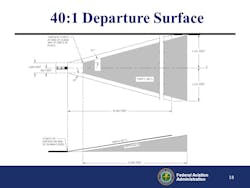The Federal Aviation Administration (FAA) considers navigable airspace a limited national resource. It is defined as the airspace at or above the minimum altitudes of flight, including that which is needed to ensure the safe arrival and departure of aircraft. To ensure appropriate airspace protection and obstacle clearance, the FAA requires a civil airport to establish restrictions on the heights of buildings, antennas, trees, signs and other objects near its runways.
The provisions of FAR Part 77, “Safe, Efficient Use, and Preservation of the Navigable Airspace,” determine a complex structure of imaginary surfaces in relation to each runway, as well as standards for developing terminal instrument procedures (TERPS) to ensure safe aircraft operations. The size of each imaginary surface is based on the category of runway and type of instrument approach available. If an obstacle is allowed to penetrate any imaginary surface, the FAA deems it a hazard to air navigation because it affects approach and departure minimums.
For airports, this regulation determines:
- The requirements to provide notice to the FAA of certain proposed construction, or the alteration of existing structures;
- The standards used to determine obstructions to air navigation, and navigational and communication facilities;
- The process for aeronautical studies of obstructions to air navigation or navigational facilities to determine the effect on the safe and efficient use of navigable airspace, air navigation facilities or equipment; and
- The process to petition the FAA for discretionary review of determinations, revisions, and extensions of determinations.
There are basically five imaginary surfaces which the FAA applies to public-use airports for the purpose of determining obstructions to air navigation: primary surface, approach surface, transitional surface, horizontal surface and conical surface. These emanate from the runway centerlines and are dimensioned according to the visibility minimums associated with the approach to the runway ends and size of aircraft to operate on each runway.
First enacted in 2011, imaginary surface requirements propose real threats to on-airport development projects across the nation, as well to the negotiation of new leases for development or the extension of previously grandfathered properties. Airports are a vital economic asset to regions and communities. Thus, height restrictions have the unintended consequence of reducing airport access, the aviation industry’s corresponding economic contributions and, most importantly, the need for airports to meet operational demand for aeronautical facilities.
In addition, these restrictions may inadvertently result in negative impacts to flights used for business, goods movement, flight training, medical emergency flights, disaster relief, recreation, air patrol and other important uses.
Curt Castagna, president and CEO of Aeroplex/Aerolease Group, is a member of the Los Angeles County Airport Commission, president of the Van Nuys and Long Beach Airport Associations, and a board member of the National Air Transportation Association. A certified private and instrument-rated pilot, he has instructed courses in aviation administration at Cal State Los Angeles for over two decades.

